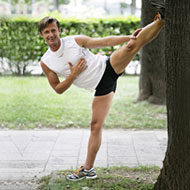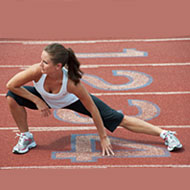- Arm Stretches
- Chest Stretches
- Shoulder Stretches
- Leg Stretches
- Knee Stretches
- Lower Back Stretches
- Running Stretches
- Back Stretches
- Thigh Stretches
- Groin Stretches
- Neck Stretches
- Glute Stretches
- Hip Stretches
- Golfers Stretches
- Calf Muscles Stretches
- Ankle Stretches
- Iliotibial Band Stretches
- Piriformis Stretches
- Warm Up Stretches
- Dynamic Warm Up Stretches
- Soleus Stretch
- Gastrocnemius Stretch
- Lumbar Stretches
- Quadricep Stretches
- Ballistic Stretching
- Adductor Stretch
- Bicep Stretch
- Triceps Stretch
- Spine Stretches
- Upper Back Stretches
- Abdominal Stretches
- Types of Stretching
Hamstring Stretches
Hamstring muscles refer to those muscles that lie on the back of the upper leg and the thighs, running from just beneath the knee up to the buttocks. They are strong muscles that can stretch up to 1.5 times their size, with regular stretching exercises.
These muscles are used in almost all physical activity, and so, keeping them stretched and supple goes a long way in improving overall flexibility and strength.
Hamstring stretches are popular exercises used by gymnasts, runners, and sprinters to improve the flexibility of their muscles and to get ready with a warm up stretch before a track event or a cross country run. Doing a dozen easy hamstring stretches with just the wall or a sturdy chair for support loosens up tight muscles and improves blood flow to the lower limbs. Hamstring stretches for runners serve to make the muscles more flexible, preventing injury and tearing of the muscles. It must be understood that these stretches have a better effect on flexibility over a period of time as they relax the muscle even as it stretches a little more every day. There are several yoga poses that double as yoga hamstring stretches, such as the Uttanasana (Standing Forward Bend). The Head to Knee yoga pose serves to strengthen the hamstring muscle even as it is stretched. The Trikonasana (Triangle Pose) not only makes the hamstring muscles more flexible but also helps to relieve back pain. Those people with back aches that result from being seated for hours at a desk or in front a computer screen should also practice hamstring stretches on a regular basis so as to make back pain a thing of the past.
Types Of Hamstring Stretches
You can do a bunch of hamstring stretches at home, at your desk in the office, while sitting on a bench at the park before you start your run, or even standing near a wall anywhere because doing these stretches does not require any special equipment .
Hang Over Hamstring Stretch:
It is one of the easiest to perform as all you have to do is stand with your feet apart at shoulder width and bend your upper body so that you can touch your toes with your fingers. You can feel the hamstring muscle stretch as you bend over; hold the pose for 10 seconds before slowly getting back to an upright position. If you need to, bend your knees slightly to make it easier on your back. For those who can touch their toes easily, the next step is to grab an ankle with each hand and hold it for 10 seconds before straightening up.
Seated Hamstring Stretch:
It can be done in two ways. You can sit on the floor with your legs and arms extended straight out in front of you and bend your torso so that your forehead touches your knee and your fingers reach for the tops of your toes .
A variation of this stretch is when, being seated, you bend the left knee and place the left foot on the inside of the right thigh and lean forward from the hips and feel the hamstrings stretch.
Standing Hamstring Stretch:
This stretch can be performed by taking a position facing a wall, pushing it with both palms while one foot is moved a step behind, keeping both heels pressed to the floor. Complete the stretch by moving the other foot back and repeating the pushing action.
Advanced Standing Hamstring Stretch:
In this stretch, you need to place the right foot ahead of the left and bends the left knee, allowing it to take the body's weight. With the right heel firmly on the floor, point the toes into the air, lean forward at the hip, keeping the back straight, and feel the hamstring in the right leg stretch. Repeat the action with the other leg to complete the stretch.
Lying Hamstring Stretch:
It is the easiest amongst all, where you lie down with one leg stretched out and the other leg raised, bent at the knee to enable you pull it towards your chest and hold it for a few seconds before releasing it slowly. Several variations of this stretch are used in yoga poses too.
Doing a hamstring stretch on a chair at work in the middle of the day not only relaxes the muscles in the leg but also leads to better blood circulation, resulting in better alertness at the workplace. Leaning forward from the hips towards the leg placed on the chair is another hamstring stretch that also helps to relieve back pain.
Hamstring Stretches : Dos and Don'ts
Hamstring stretches dos and don'ts emphasize listening to your body and knowing your limits when you stretch. Stretching is meant for warm muscles, not cold ones. While a mild tension or discomfort is common initially when you stretch stiff muscles, pain and acute discomfort are signals to stop and gently reverse the pose.
Do's
- Always hold the stretch to a point that is comfortable and at the same time take a couple of deep breaths before releasing the stretch.
- The best thing about stretching exercises is that you can start enjoying the increased flexibility and agility after a few weeks and push the envelope by stretching as much as you can.
Dont's
- Stretching is meant for warm muscles, not cold ones. While a mild tension or discomfort is common initially when you stretch stiff muscles, pain and acute discomfort are signals to stop and gently reverse the pose.
- Care should be taken to breathe deeply through every stretch as the body needs the oxygen you breathe in.
- Ensure you hold the stretched pose no longer then 10 seconds without rocking or bouncing, to avoid straining, overstretching or pulling the muscle.
- Remember that mild tension is fine during a stretch, but make sure you do not stretch beyond a point where you feel pain.
Hamstring Stretches Benefits
- Improved blood circulation and relief for an aching back, besides the obvious advantage of a supple body that you can bend at will.
- Breathing too gets regulated as one inhales and exhales deeply as the muscle is stretched and relaxed.
- These stretches can be done by anyone: children, women, adults and even seniors, who can choose to do those exercises they find comfortable.
- Hamstring stretches can also help provide relief from a chronic back pain.
- Longer muscles provide relief from lower back pain and ease away the aches.
- Stretching your hamstring before and after you finish your workout improves the flow of blood to your muscles.
- Increased blood flow to your muscles also means an increased flow of oxygen.
- If the stretching is included in your routine, your muscles are less sore after a work-out.
- Stretching carries extra nutrients to your muscles and prevents any discomfort, thus helping you to recover faster after your work-out.
- As a result of this, you can get better results and perform even more exercises.



